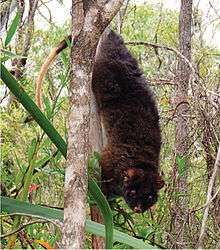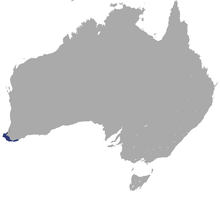Western ringtail possum
| Western ringtail possum [1] | |
|---|---|
 | |
| Scientific classification | |
| Kingdom: | Animalia |
| Phylum: | Chordata |
| Class: | Mammalia |
| Infraclass: | Marsupialia |
| Order: | Diprotodontia |
| Family: | Pseudocheiridae |
| Genus: | Pseudocheirus |
| Species: | P. peregrinus |
| Subspecies: | P. p. occidentalis |
| Trinomial name | |
| Pseudocheirus peregrinus occidentalis | |
 | |
| Western Ringtail Possum range | |
The western ringtail possum or Ngwayir is a possum found in a small area of Western Australia, regarded as a subspecies (Pseudocheirus peregrinus occidentalis) of the common ringtail possum, or as a separate species. It is a small animal with dark greyish-brown fur without any rufous tinge, pale underparts and a long prehensile tail with a pale tip. It is nocturnal and mainly arboreal, feeding on buds, leaves, flowers and fruit. It breeds mainly in the winter, the single juvenile emerging from the pouch after about three months. Its population seems to be declining, probably due to habitat loss and the introduction of alien species, and the International Union for Conservation of Nature has rated it as "endangered".
Description
The western ringtail has a head and body length of 320–400 mm, a tail length of 300–400 mm, and a weight of 820-1100 g (1300 g[3]). It has dark grey brown fur with light patches behind the ears and creamy white, sometimes greyish, underparts. It differs from the common ringtail possum by lacking any rufous colouration. It has a long prehensile tail with a distinctive white tip.[4]
The original description of the western population was as a separate species, Pseudocheirus occidentalis,[5] though later authors classified it as a subspecies of Pseudocheirus peregrinus. Due to contradictory research, a recommendation to reinstate the species status—though a widely held view—has not been published.[3]
Distribution and habitat
The western ringtail is confined to south-western Western Australia where it is now reduced to patches of mainly eucalypt forest between Two Peoples Bay and the Collie River, with the most inland population at Perup. The species favours coastal forest with Agonis flexuosa, its range includes gardens in the cities of Busselton and Albany.[3][4]
Behaviour
The western ringtail is an arboreal and nocturnal herbivore with a relatively small home range of 0.5-6 ha, dependent on habitat type. It uses tree hollows and builds dreys for shelter in tree canopies.[6] They are primarily arboreal, but will often move through understorey or open ground to feed or gain shelter. Sheltering at ground level is recorded, though not usual, more frequently be found at hollows and the upper story of a forest; the species has occasionally be seen to occupy rabbit burrows.[3]
Diet
Its diet includes leaves, shoots, fruit and flowers of a range of plants. Favoured food trees are jarrah, Eucalyptus marginata, and marri, Corymbia calophylla, with the peppermint tree Agonis flexuosa forming the greatest part of their diet.[3]
Breeding
Births occur mainly in winter, usually of only one young. The young emerge from the pouch at about three months of age, when they weigh about 125 g, and suckle until they are 6–7 months old, weighing about 550 g.[6]
Conservation
The western ringtail has declined in abundance and range because of habitat destruction and red fox predation.[4] Current threats include ongoing habitat loss and predation by introduced species. Altered fire regimes have had significant impact on many groups, high intensity fires removes suitable refuge and large burns can clear an area of food, causing starvation. It is classified by the International Union for Conservation of Nature as "endangered".[2]
References
- ↑ Groves, C.P. (2005). Wilson, D.E.; Reeder, D.M., eds. Mammal Species of the World: A Taxonomic and Geographic Reference (3rd ed.). Baltimore: Johns Hopkins University Press. p. 51. OCLC 62265494. ISBN 0-801-88221-4.
- 1 2 Morris, K.; Burbidge, A. & Friend, T., A. (2008). "Pseudocheirus occidentalis". IUCN Red List of Threatened Species. Version 2008. International Union for Conservation of Nature. Retrieved 9 October 2008. Listed as Vulnerable(VU B1ab(ii,iii,v) v3.1)
- 1 2 3 4 5 "Pseudocheirus occidentalis — Western Ringtail Possum". Species Profile and Threats Database. Department of Sustainability, Environment, Water, Population and Communities. Retrieved 3 November 2010.
- 1 2 3 Menkhorst, Peter & Knight, Frank (2001). A Field Guide to the Mammals of Australia. Melbourne: OUP. ISBN 0-19-550870-X.
- ↑ Thomas, O (1888). Catalogue of the Marsupialia and Monotremata in the collection of the British Museum (Natural History). London: Trustees of British Museum (Nat. History).
- 1 2 "Naturebase documents: Western Ringtail Possum" (PDF). Retrieved 2007-12-03.
